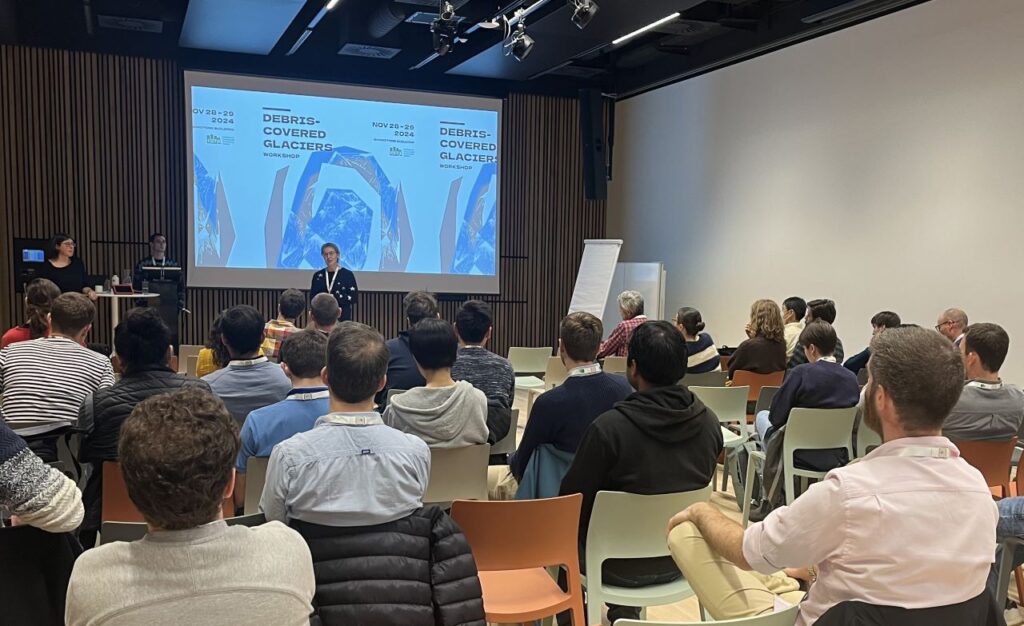The MegaWat Annual Meeting a resounding success!
Held on October 8-9, 2025, in the Ballroom at ISTA, the event was a powerful demonstration of our consortium’s commitment. We proudly welcomed nearly all our members, including representatives from ISTA, WSL, ETH, Utrecht University, FutureWater, and CNR. The core of the meeting was devoted to showcasing the progress across all work packages. Through focused discussion, we were able to align our strategies and collectively chart the most effective path forward, ensuring the continued momentum and success of the MegaWat project.
This connects to recent work presented at the IMC conference (see here)
This builds upon recent presentations by Katrina Gelwick and Maximiliano Rodriguez, at the International Mountain Conference (IMC25) from September 14–18. Katrina presented her preliminary modeling results for the Pyrenees, while Maximiliano showcased his findings for the Apennines. Their combined work unveiled intriguing patterns in catchment evapotranspiration. Specifically, they detailed how high-elevation vegetation can exhibit increased transpiration during drought conditions as previously observed for the Alps—a counterintuitive result that is shaping our understanding of water cycle dynamics. Follow our progress for more groundbreaking results!




Losing their cool! New study shows how mountain glaciers will recouple to the warming of their surroundings.
Dr. Thomas Shaw leads a new paper, published in Nature Climate Change!
The study pieces together air temperature information from weather stations on glaciers around the world. Combining data from the group’s past and present research projects, publicly available data, as well as data requested from others in the community, the study quantifies by how much glaciers are cooler than their surroundings due to the presence of local katabatic winds and what predicts the strength of that cooling.
The study estimates that a ‘peak’ in this cooling will be reached in the coming decades, if not already for some regions, and will disappear as glaciers retreat, fragment and decay. This loss of localised cooling will only make glaciers more sensitive to ongoing warming and results in non-linear responses to future warming that is often assumed from simpler glacier models.
Decreasing snowfall undermines glacier health in previously stable region
Achille Jouberton leads a new paper published in Nature Communications Earth and Environment! The research explores critical questions regarding a turning point for glacier health in a region that has been relatively stable until the last decade. The work finds that reduction of precipitation and snowfall in particular has driven increasingly negative glacier mass balances in the Northwestern Pamirs. Check out the paper here!
This work was also picked up by Austrian ORF for radio and television! 🙂
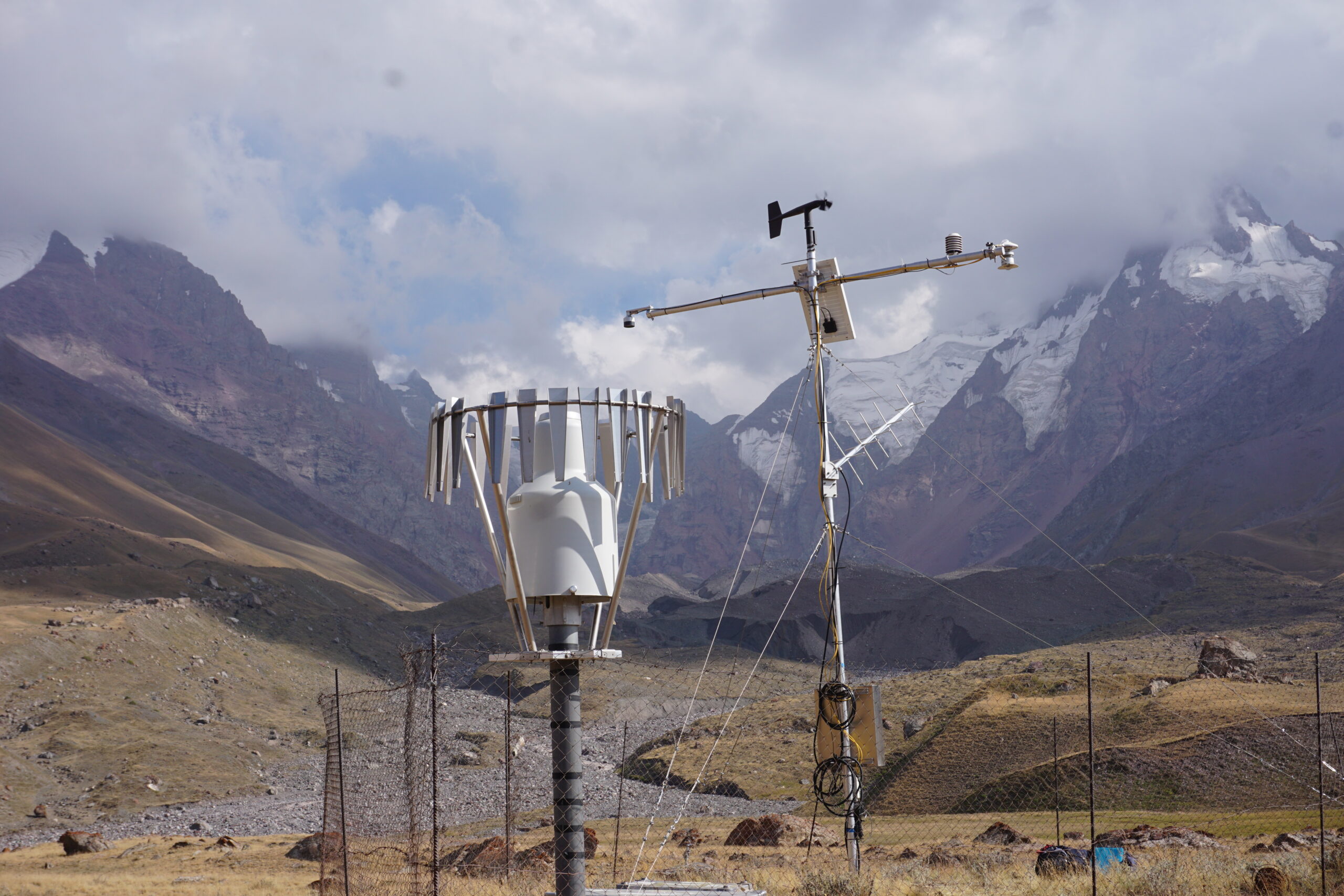

Adventures at the top of the Andes
Dr. Catriona Fyffe writes a new blog post about conducting fieldwork at high altitudes in the Peruvian Andes. The work, aligning to the PASTURE and EPIC projects, explores the role of Andean glaciers and their role within the functioning of the mountain hydrological system. Check out Cat’s blog post below:
Read More
I work as a glacier-hydrologist within the Pellicciotti group, where we focus on understanding the mountain cryosphere and its impacts on downstream water resources. I returned to the Peruvian Andes this June with Joshua Castro (PhD student at Uni. Fribourg) to investigate the high elevation glaciers and ecosystems that exist in this incredible mountain region. We work closely with a range of partners in the region at INAIGEM (Institute of Research in Mountain Glaciers and Ecosystems), ANA (Peruvian National Water Authority), UNASAM (National University of Santiago Antunez Mayolo, in Huaraz) and UNSAAC (National University of San Antonio Abad del Cusco, in Cusco).
Exploring the intricacies of high elevation glaciers and their linked wetlands
After a few days in Cusco of organising and acclimatising we filled a minibus with the team (including our guide Adrian, his wife, two cooks, our field assistant Miguel and Michael, a photographer) and all our kit. The first few nights we camped in the Qori Kalis catchment at around 4800 m a.s.l.. We were also joined by a team from INAIGEM (Renny, Aracely, Cristian and their driver). The setting is incredible, but my goodness it was cold! Temperature sensors inside my tent recorded down to -4˚C. Staying warm required wearing four layers inside my big sleeping bag which had an extra fleece liner and a hot water bottle!

The Cordillera Vilcanota is home to the majestic Quelccaya Ice Cap and nearby mountain glaciers, whose melt water is vital to the communities below. The southern hemisphere winter is the dry season in Peru, with little precipitation – meaning that at this time of year the melt water from the glaciers is particularly valuable. This water is especially useful to maintain the high elevation wetlands (known as ‘bofedales’) which are a favourite grazing ground for alpacas, and are therefore a sought after resource by the local farmers. To understand more about the glaciers and their links to the wetlands the team has a variety of sensors, including loggers to monitor the wetland and river water level, soil moisture and temperature sensors, trail cameras and weather stations. On top of the routine monitoring we also conducted multispectral drone flights, used to capture the detailed topography and vegetation characteristics. We are especially interested in the functioning of the bofedales and how their fluctuations are tied to changes in glacier melt and snowfall, and conversely how the bofedales themselves alter downstream runoff patterns compared to the inputs from higher in the catchment. Our collected data will be used to feed into mechanistic models of the entire landscape that can quantify exactly the flows of water and energy between the different components of the system.
We moved next to the relative comfort of the village of Phinaya, which is both several hours from the nearest city, and at the same time in the centre of the alpaca herding communities in the region. We were excited to spend a day with the children in the primary and secondary schools here, continuing our work from last year. With the younger kids we held a workshop based on the seasons, contrasting those in Peru with Austria. Their enthusiasm and energy was great to see! We also worked with the secondary school, helping them develop mini research projects related to glacier change. We were very grateful to the teachers for allowing us to work with the kids, and to the VISTA team here in helping us to prepare.


Myself (lower) and Joshua (upper) working with the children in Phinaya primary school. Photos were taken by Micheal Bednar. Permission was received from the school head teacher to share images of the children.
We continued with fieldwork in the neighbouring Alyripampa catchment, where we also have a suite of monitoring instruments. However, this year we added a set of three snow monitoring stakes, which are simply marked poles monitored hourly by trail cameras. The snow dynamics here are fascinating, snow falls often in the wet season in the evening, but after just a couple of hours in the morning sunshine it can be gone. This makes it very difficult to monitor from satellites, which capture daily imagery at best. Our analysis of existing trail camera imagery has revealed that we can capture many more snow events than satellites, providing promise for a greater understanding of these rapid snow processes. Our highest stake was installed at around 5100 m a.s.l. next to the Quisoquipina and Suyuparina glaciers, and nearby a weather station installed by UK-based researchers. In return for using their enclosure we did some maintenance of their station; nice to add a little international cooperation to the trip! Next we had a bit more logistics to navigate, a day’s drive back to Cusco, meetings with INAIGEM, a flight to Lima, then after a day in Lima for recuperation and catching up with some fellow researchers, we took the night bus to Huaraz and the majestic Cordillera Blanca.

How’s the weather station?
We had only one day to organise in Huaraz before we joined Alexzander and Fredy from INAIGEM on a day trip to Llaca glacier. The purpose was to maintain an automatic weather station that was installed last year with the aim of improving our understanding of the effect of rock debris on the melt of tropical glaciers (a focus of Fredy’s Masters project conducted within the PASTURE project). The melt from Llaca glacier is also vital, being one of two catchments used to supply drinking water to Huaraz. The valley is also a considerable source of flood risk for the city, and in April this year a large rock slope failure into a lake mid-way down the valley caused a massive debris flow and flood downstream, damaging around 100 houses and claiming the lives of 2-3 people. It was good to see signs of recovery, with the road to the glacier open again.
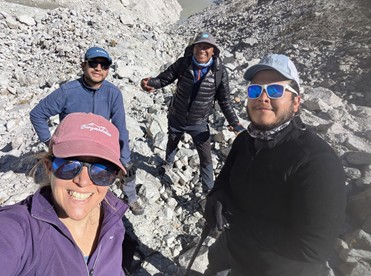
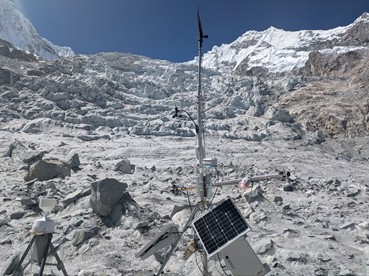
Below, our automatic weather station on Llaca Glacier, and above the team on the debris (rock)-covered part of the glacier, including myself, Alexzander, Fredy and Joshua..
Plant succession in the deglaciating Andes
Finally, we left for the last stage of fieldwork – for a few days to Shallap Glacier. We went with a large team, including Katy and Edwin from UNASAM, Rolando from ANA, a guide, two cooks and five porters. The way to Shallap involves a 3 hour walk from the road through a gorgeous valley, filled with lupins and the unique Polylepis trees. We also had to employ some donkeys to carry the equipment, including the science gear, food and gas for the stoves. Our focus here had three objectives: first was to survey the succession vegetation that has grown since the recession of the glacier up the valley, second to add another four ‘snow stakes’ to monitor the snow conditions in the Cordillera Blanca, and third to maintain all the instruments the team have across the catchment. I’m really interested in the impact of the new vegetation on the catchment water cycle and how it compares to the impact of the changing glaciers, and all of this data will feed into our modelling efforts. It’s quite incredible to see how plants can survive in such tough and ‘new’ environments. It was also super to have such a strong team as we were able to do nearly all the measurements in a short time, especially impressive given the steep climb up to the glacier. Unfortunately, I was very ill one night so we came down a little early (me by donkey, as I didn’t have the energy to walk). Luckily, after a full rest day I was almost recovered, just in time for a few more meetings, and a couple of days holiday, before the long journey home. I’m always supremely grateful to all our Peruvian partners who make all of this work possible, and make it a lot more enjoyable too!
If you want to find out more about our group then head to our website, and more about my current and past research can be found on ResearchGate .
Cat Fyffe, Marie Curie Postdoctoral Fellow, Pellicciotti Group
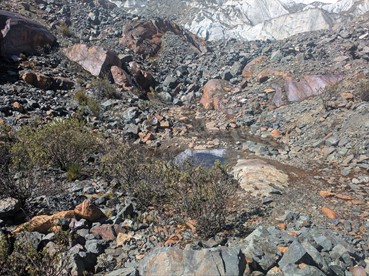

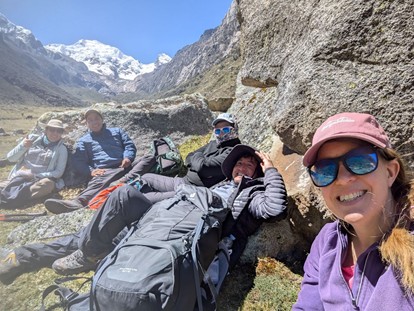
Snow is surprisingly important for water resources in the Peruvian Andes
A new paper led by Catriona Fyffe has just been published in Nature Communications Earth and Environment! She shares a blog post providing an overview of the research and the new findings from the paper. Read More Here
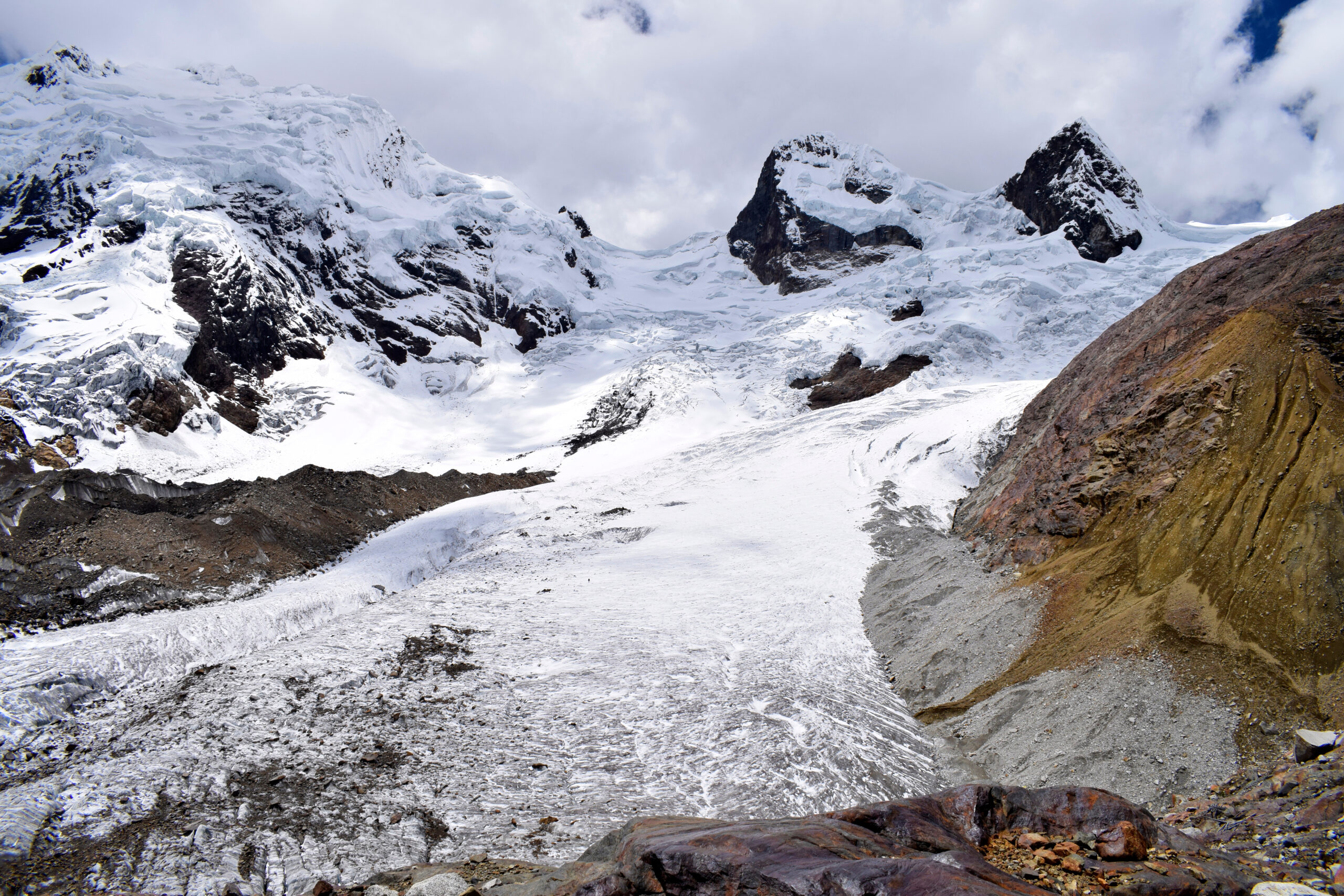

We go to EGU EGU Comes to us
Several members of the group attended this year’s European Geosciences Union (EGU), which makes an annual visit to us here in Vienna! EGU25 brought over 19,000 geoscientists from around the world to our doorstep, and gave us the opportunity to showcase some of our current science within the cryospheric, hydrological and atmopsheric science disciplines. Read more about our group’s presentations below:
Read More

Adria Fontrodona-Bach started us off with an invited PICO presentation about the newly available debris properties database “DebDaB” in session CR1.2 “Observing and modelling glaciers at regional to global scales”.
https://meetingorganizer.copernicus.org/EGU25/EGU25-10102.html
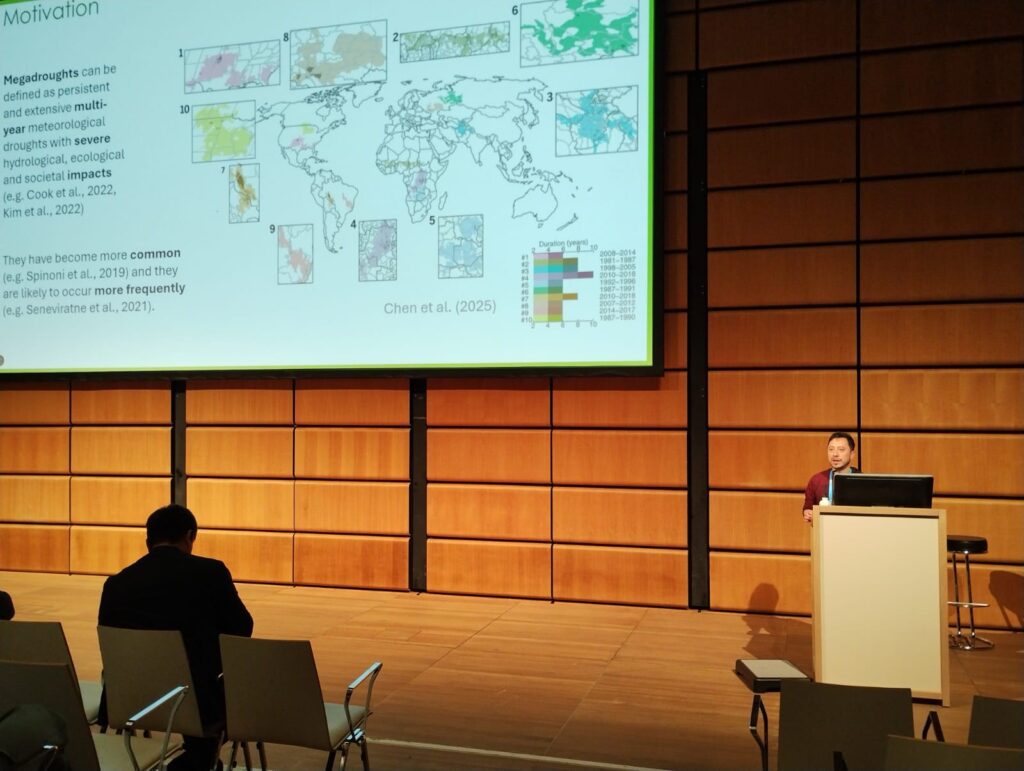
Álvaro Ayala followed up on Wednesday morning with an invited oral presentation about the role of glaciers under drought conditions in central Chile. Early risers were given a great talk in the hydrology session HS2.1.1 “Snow and glacier hydrology”.
https://meetingorganizer.copernicus.org/EGU25/EGU25-18065.html
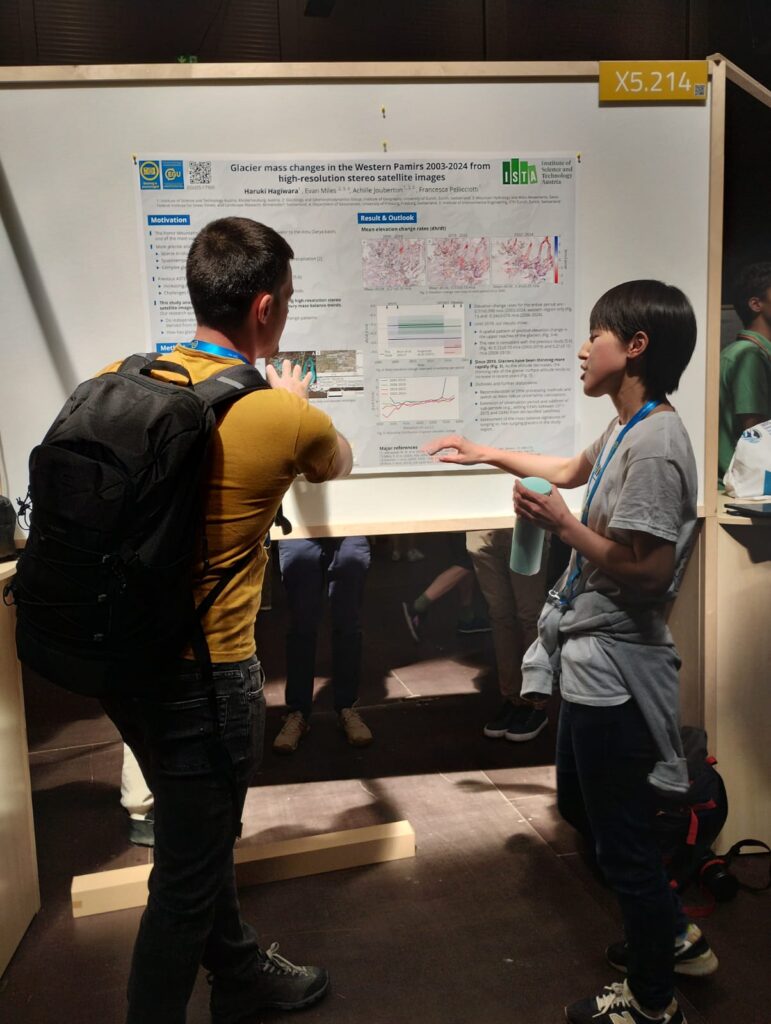
Haruki Hagiwara was up next to present her work on geodetic change detection in western Pamirs using high resolution stereo imagery. Her poster was part of the CR1.3 session “Glacier monitoring from in-situ and remotely sensed observations”. https://meetingorganizer.copernicus.org/EGU25/EGU25-17900.html

Guest visitor Harol Granados also presented his working in this session, looking at the contrasting responses of clean and debris covered glaciers in the Cordillera Blanca of Peru. https://meetingorganizer.copernicus.org/EGU25/EGU25-14455.html

The Wednesday afternoon also brought a poster presentation by Achille Jouberton with his work on reconstructing the water balance of high elevation catchments across High Mountain Asia. His work was presented as part of the “Snow and glacier hydrology”. session. https://meetingorganizer.copernicus.org/EGU25/EGU25-10423.html

A row behind him, Shaoting Ren was showing off his approach to invert remote sensing observations to explore biases in the high elevation meteorology over glaciers as part of INARCH-led session, HS2.1.3. https://meetingorganizer.copernicus.org/EGU25/EGU25-17515.html
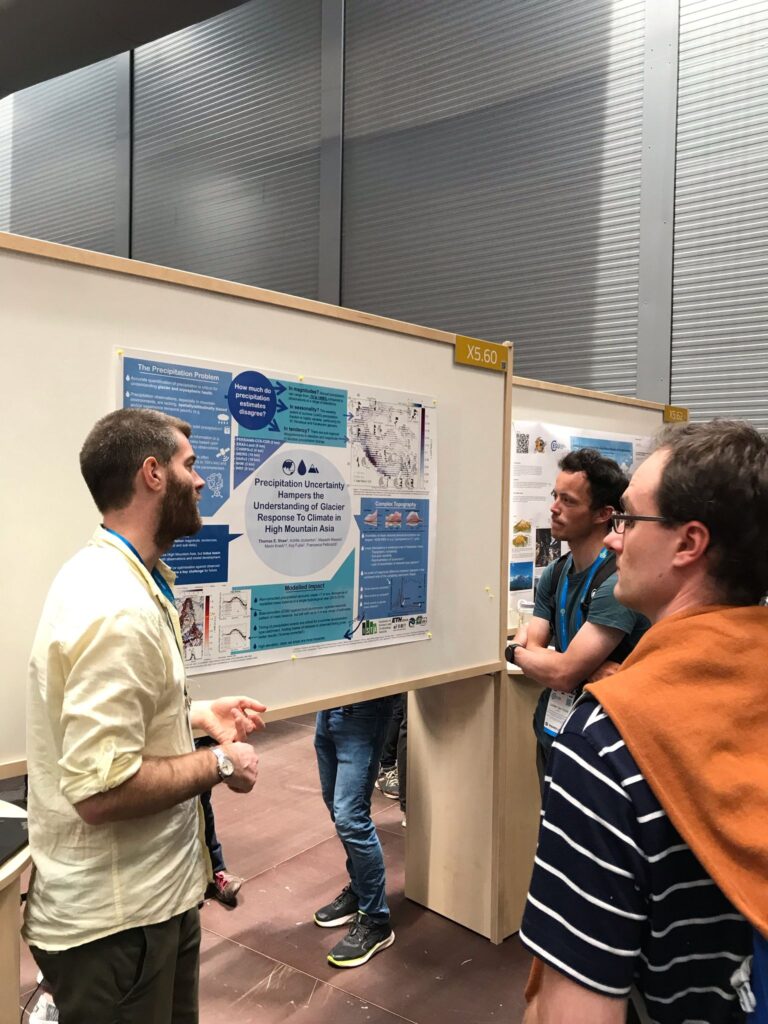
Thursday afternoon was host to a poster presentation on uncertainty of high mountain precipation in Asia by Thomas Shaw as part of the “Mountain Weather and Climate” session (AS 1.38). https://meetingorganizer.copernicus.org/EGU25/EGU25-6679.html

Meanwhile, Prateek Gantayat was showcasing his work on a coupled iceflow and mass balance model with debris cover evolution as part of CR2.1, “Modelling ice sheets and glaciers”. https://meetingorganizer.copernicus.org/EGU25/EGU25-18027.html

…and his immediate neighbour, José Muñoz was highlighting his work on reconstructing debris supply and debris extent as part of the same session. https://meetingorganizer.copernicus.org/EGU25/EGU25-17446.html

Finally, Friday morning was Thomas Shaw‘s turn behind the microphone (albeit with little voice remaining), while convening a ‘cool’ session of cryosphere-atmosphere interactions. The PICO session brought about many interesting presentations and discussions regarding glaciers and their role in the mountain climate system. https://meetingorganizer.copernicus.org/EGU25/session/53842
The First World Day for Glaciers.
Glaciers are rapidly melting, a warning sign of the impact of climate change. On the occasion of the first World Day for Glaciers, ISTA conducted an interview with the group leader Francesca Pellicciotti. Read her thoughts on the importance of glaciers, the best and worst-case scenarios for our planet, and her personal experiences conducting research in some of the world’s most remote landscapes (ARTICLE).


Multiyear droughts are worsening! A new analysis reveals where are the most affected regions.
New research co-authored and co-led by the Pellicciotti Group find that >13,000 droughts spanning more multiple years during that last four decades. This analysis is related to the goals of the EMERGE and MEGAWAT projects. Read more here.
Chen, L., Brun, P., Buri, P., Fatichi, S., Gessler, A., Mccarthy, M. J., Pellicciotti, F., Stocker, B., & Karger, D. N. (2025). Global increase in the occurrence and impact of multiyear droughts. 2014(4), 278–284. https://doi.org/10.1126/science.ado4245
16/01/2025
Group hosts international workshop on debris-covered glaciers.
The Pellicciotti group were delighted to welcome nearly 60 scientists who study debris-covered glaciers to a 2 day workshop held in the Moonstone seminar centre in November. It was an excellent opportunity to gather this vibrant community together to discuss the latest advances and further community initiatives, as well as introduce ISTA as a home of excellent research in Cryosphere and Earth Sciences.
Read More
Highlighting world-class research on debris-covered glaciers
Sessions in the workshop covered a wide range of glacier research, spanning the evolution of debris-covered glaciers, their mass balance and hydrology, glacier meteorology and energy balance studies and remote sensing of glaciers. We were delighted to host an excellent range of talks and posters from across the community, from both new and established scientists. We were especially glad to welcome invited speakers to begin each of the sessions. Ann Rowan (University of Bergen) opened the first session discussing the dynamics of debris-covered glaciers and their response to climate, focussing on her state-of-the art modelling of debris and glacier evolution. Duncan Quincey (University of Leeds) gave the audience insights into the challenges of understanding englacial processes within the debris-covered glaciers of High Mountain Asia and introduced a new project to assess ice temperatures at even higher elevations on the Khumbu Glacier icefall that flows down from Mount Everest. Tobias Bolch (Graz University of Technology) gave an excellent overview of recent progresses monitoring debris-covered glaciers from remote sensing, and assessing their flow velocity and elevation changes.
Building on community efforts
The workshop was designed to give ample time to build on and start new community efforts. So alongside traditional talks there were also plenary and breakout sessions allowing discussion across the group. This was an excellent chance to bring together insights from different disciplines interested in debris-covered glaciers and build momentum for community efforts. In particular we started to build a framework for a perspective paper on the current state and future directions for debris-covered glacier research; began discussions for a potential Marie Skłodowska-Curie Doctoral network; and discussed the potential future directions of the IACS (International Association of Cryospheric Sciences) Working Group on Debris-covered glaciers. We hope that these discussions are just a start of these exciting initiatives which involve many of the Pellicciotti group. Alongside the main workshop we also held a hybrid panel discussion on the methods for measuring the hydrology of debris-covered glaciers – where experienced researchers Doug Benn, Evan Miles and Katie Miles (who zoomed in from fieldwork in Antarctica!) gave insights into their fieldwork approaches. Community cohesion was further enhanced through the engaging poster session and during the conference dinner in Fischer Bräu, where the size of the schnitzel was appreciated by attendees!
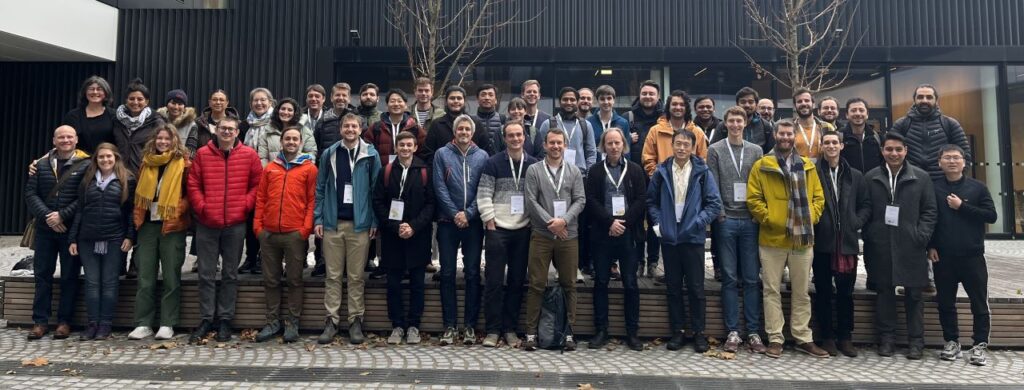
We thoroughly enjoyed hosting the workshop and hope to repeat it in future years. ISTA provided generous financial support to the event and were able to fund the participation of three early-career scientists from Argentina, India and the USA. The organising committee of Francesca Pellicciotti, Adrià Fontrodona-Bach, Vicente Velasco, Catriona Fyffe and Evan Miles would especially like to thank Lilla Kukor from event management for all her help and the IT and catering team for ensuring the event was such a success.
